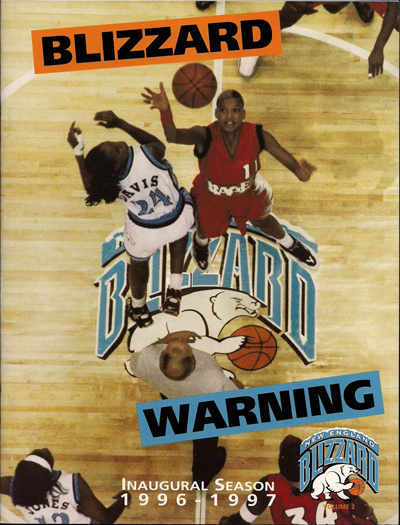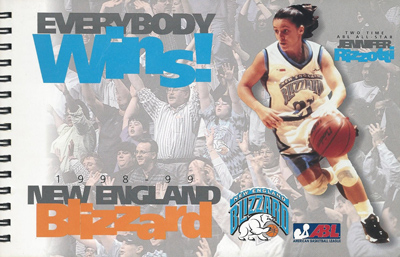American Basketball League (1996-1998)
Tombstone
Born: February 1996 – ABL founding franchise
Folded: December 22, 1998
First Game: October 18, 1996 (W 100-73 vs. Richmond Rage)
Last Game: December 19, 1998 (W 80-76 vs. Nashville Noise)
ABL Championships: None
Arenas
Hartford Civic Center (15,340)11997-98 American Basketball League Media Guide
Opened: 1975
Springfield Civic Center (8,140)21997-98 American Basketball League Media Guide
Opened: 1972
Marketing
Team Colors: Columbia Blue (PMS 298), Black, White & Orange (PMS 165)31997-98 American Basketball League Media Guide
Ownership
Owner:
- 1996-1998: American Basketball League
Investor-Operator:
- November-December 1998: Phoenix Home Life Insurance
Attendance
The New England Blizzard led the American Basketball League in total and average attendance in all three seasons of operation.
Tilting your mobile device may offer better viewing.
Sources:
- 1997-98 American Basketball League Media Guide (1996-97 figures)
- 1998-99 San Jose Lasers Media Guide (1997-98 figures)
- Fun While It Lasted box score analysis of all 63 1998-99 ABL games from NewspapersArchives.com. (1998-99 figures)
Background
The New England Blizzard were a very popular women’s basketball franchise in the short-lived American Basketball League (1996-1998). The Blizzard finished in last place for two of their three seasons of play, but this didn’t seem to diminish the team’s appeal. New England led the ABL in attendance every season, including a peak of 8,857 per game in 1997-98, which was more than double the league-wide average.
Big Stars & Solid Pay
Notable players included guard Carolyn Jones, who led the ABL in scoring (21.2 ppg) in 1996-97, and former UCONN stars Jennifer Rizzotti and Kara Wolters. Players like Rizzotti and Wolters were emblematic of the ABL’s noble attitude towards player salaries and benefits. Rizzotti inked a 3-year, $450,000 deal on the eve of the ABL’s final season. Wolters got 3 years at $200,000 per season as a rookie out of UCONN in 1997. Across the league, ABL salaries averaged $80,000 per year in 1997-98, which was more than double the average pay in the rival Women’s National Basketball Association, which debuted in the summer of 1997. As a result, the ABL attracted better players overall. But the NBA-backed WNBA spent much more on marketing and earned better television deals and far larger crowds.
Hartford & Springfield
During their debut season, the Blizzard played the majority of their games (12) at the Springfield (MA) Civic Center. In Springfield, the Blizzard were a typical ABL club. They averaged 3,406 fans for a dozen home dates, right on par with the league-wide average. But in Hartford, the team was tremendously popular, drafting off the popularity and traditions of the celebrated UCONN college program and pulling an average of 7,412 fans for eight home games. This included a league-record crowd of 11,873 for a January 25, 1997 game against the San Jose Lasers at the Hartford Civic Center. Heading into the 1997-98 season, the Blizzard flipped the script, scheduling sixteen home dates in Hartford and only six in Springfield.
Struggle for Investors
Hartford was also home to one’s of the ABL’s most emotionally and financially engaged boosters. Robert Fiondella was the chairman of Hartford-based Phoenix Home Life Insurance and also the head of the Greater Hartford Chamber of Commerce. The ABL found the sponsorship market for women’s pro basketball to be especially challenging. Phoenix Home Life was an exception, signing on as one of the league’s first national corporate partners in October 1996.
In April 1997, Fiondella and Phoenix Home Life invested an additional $3 million to acquire a 20% equity interest in the ABL, as well as an option to purchase operating rights to the Blizzard franchise. Under the ABL’s single entity structure, all franchises and player contracts were owned by the league, but the sale of operating rights allowed local investors to manage a team’s front office operations and retain all local revenue. Combined with a simultaneous $3 million infusion from Silicon Valley venture capitalist Joe Lacob for league equity and operating rights to the San Jose franchise, the ABL was able to offset most if not all of it’s reported $4M – $6M operating loss on the league’s inaugural season.
For the 1997-98 season, the Blizzard hired Basketball Hall-of-Famer and former Boston Celtics head coach K.C. Jones to coach the team. Under Jones, the team improved from the last place finish of 1997 to earn the ABL’s fourth and final playoff spot in 1998 with a 24-20 record. The San Jose Lasers swept the Blizzard in a best-of-three series in the first round of the 1998 ABL playoffs.
Bankruptcy & Demise
In November of 1998, Phoenix Home Life Insurance finally exercised its 18-month old option to buy the operating rights to the New England Blizzard. The Sports Business Journal reported that the undisclosed option price was believed to be north of $1.5 million. The timing proved unfortunate for Phoenix, as the league ran out of money barely a month later. On December 21, the league’s board of directors voted to shut down immediately and file for Chapter 11 bankruptcy. The teams were barely one-third of the way through the league’s third season schedule.
At the time the ABL folded, the Blizzard had a 3-10 last place record. They also had a league-high 4,800 season ticket holders. Of the ABL’s more than 1,000 bankruptcy creditors, Phoenix Home Life Insurance was the largest, owed more than $6 million as the guarantor of a league bank loan.
Professional women’s basketball returned to Connecticut in 2003 with the transfer of the WNBA’s Orlando Miracle franchise to the Mohegan Sun Arena in Uncasville. The franchise was re-branded the Connecticut Sun.
In Memoriam
Blizzard head coach K.C. Jones passed away on Christmas day 2020 at the age of 88 while in care for Alzheimer’s Disease. New York Times obituary.
Links
###



